President Donald Trump’s 100th day in office on Saturday follows a campaign in which he promised to revolutionize the US government’s role in virtually all areas.
Here are a few figures from his tenure so far.
Executive actions and bills signed
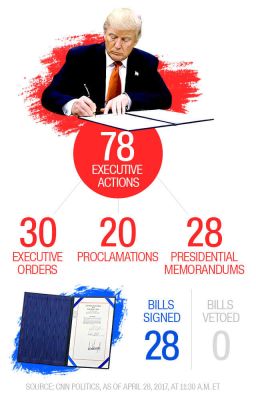
Trump has taken dozens of executive actions and signed many bills into law to roll back regulations formulated under his predecessor, President Barack Obama.
The court system has held up his two attempts by executive order to institute a travel ban on people from several majority-Muslim nations and one executive order targeting so-called sanctuary cities.
Trump has relied heavily on the use of executive orders during his first 100 days in office to quickly rack up wins for his presidency. But as a candidate in the 2016 election, Trump decried Obama’s use of executive orders.
Calls, meetings and joint news conferences with foreign leaders
Trump has met in person with major US allies such as the leaders of Japan and Germany as well as Chinese President Xi Jinping, the leader of a nation Trump railed against on the campaign.
Time spent outside of Washington
Trump has spent seven of his 14 weekends as President at his Florida golf club, Mar-a-Lago, which he dubbed “the Winter White House” and “the Southern White House.”
During his campaign, Trump said he would be too busy to play golf, and he had for years mocked Obama for taking the time to play the game. He has gone to his own golf courses.
Cabinet diversity
Trump’s Cabinet is overwhelmingly white and male. It also includes several retired generals.
Here are the white men in Trump’s Cabinet and at the Cabinet level, including those named but yet to be confirmed.
Trump has hired six people who either aren’t white or aren’t male for his Cabinet and Cabinet-level positions: Alex Acosta, Ben Carson, Elaine Chao, Nikki Haley, Linda McMahon and Betsy DeVos.
Jobs
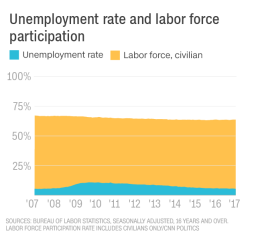
Unemployment spiked in the wake of the Great Recession, and the jobs situation has been on the mend for years. Under Trump, the jobs picture has continued to improve, although the White House has stretched taking credit for new jobs.
Stock market performance

The stock market has reached record highs following Trump’s victory.
Immigration arrests on the rise
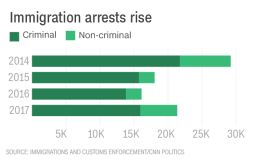
Trump promised to get tough on undocumented immigration. Preliminary data showed immigration arrests were up in the opening weeks of the Trump administration.
Illegal border crossings fall

One of the biggest changes on illegal immigration has been the documented drop in apprehensions at the Southern border, which experts attribute to Trump’s aggressive immigration enforcement policies.
Supreme Court vacancy filled
After Justice Antonin Scalia died in February 2016, Obama nominated Judge Merrick Garland to fill the vacancy. Senate Republicans said at the time that they would not consider a nominee until the next president took office. Ultimately, Trump named Neil Gorsuch to fill the spot, and the Senate confirmed him after abolishing the filibuster for Supreme Court nominees. The maneuvering assured the majority of Supreme Court justices continues to be appointed by Republican presidents.
A plan to reorganize the federal government
On January 23, Trump ordered a federal hiring freeze. On April 12, the White House ended the freeze but called for plans that would lead to major workforce reductions and shrink the size of government.
Oil pipeline projects
On January 24, Trump advanced the Keystone XL and Dakota Access oil pipelines, two extremely controversial projects that Obama held up.
Major trade deal nixed
The Trans-Pacific Partnership would have created the world’s largest free trade zone. It was a major Obama initiative, and Trump promised to kill the deal because he said it was a threat to the US economy. Early in his presidency, he withdrew the US from the TPP trade deal.
Here’s the massive size of what it would have been.
Yemen strikes ramp up
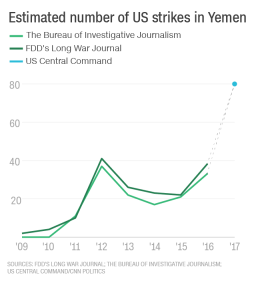
Trump approved a raid in January that led to the death of a Navy SEAL and three senior al Qaeda leaders. From the end of February, the US increased the pace of its airstrikes on al Qaeda in the war-torn nation of Yemen.
An April 24, 2017, post from US Central Command said the US had conducted “more than 80 precision strikes” against al Qaeda since February 28.
Here are estimates from the Long War Journal, a Foundation for the Defense of Democracies project, and estimates of drone strikes alone in Yemen from the Bureau of Investigative Journalism over the Obama years.
Coalition strikes in Syria and Iraq
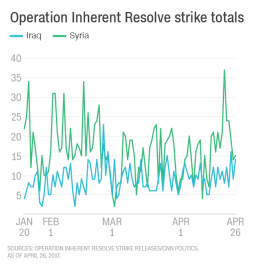
Trump authorized a strike of 59 cruise missiles against one of Syrian President Bashar al-Assad’s air force bases after the US said the Syrian government had unleashed chemical weapons on civilians, including babies.
The US in early April also used one of its largest non-nuclear bombs, known as the “Mother of All Bombs,” for the first time in combat to target ISIS in Afghanistan.
Meanwhile, Operation Inherent Resolve, a coalition led by the US to defeat ISIS in Syria and Iraq, has continued its strikes in both Syria and Iraq. Here are the numbers Inherent Resolve has reported as of April 27. Since Trump has taken office, the coalition has averaged about 9 strikes a day in Iraq and over 16 a day in Syria.


